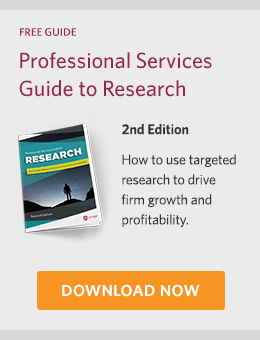When conducting brand research for your firm, choosing the right way to gather data will vary, and the decisions that you make early in the process can have a ripple effect down the line.
In order to pick the data collection method that’s right for your firm, you must first answer a few important questions:
1) Whose perspective should we target?
Targeting the right audience persona is important if you want actionable results from your brand research endeavor. For example, if you intend to grow your firm in a certain market you may want to consider the population of clients that fit the mold you’re looking for.
2) How big is the population of that audience persona?
The size of your target population plays a major determining factor in the instrument used to collect data.
3) Am I looking for quality or quantity?
Herein lies the duality of research in the professional services industry. In-depth interviews can yield deep, quality insight from a relatively small, targeted audience persona. On the flipside, the quantity of respondent data generated from online surveys can produce statistically significant results.
After determining the population you would like to sample, the next key decision is determining how to collect the data. Let’s take a look at the benefits and drawbacks of using an online survey instrument versus in-depth interviews (IDIs) when considering conducting primary brand research.
In-Depth Interviews (IDIs)
What are the benefits?
The ability to probe respondents. A talented interviewer is going to get more depth of information than someone might volunteer on an online survey. This benefit is particularly useful when dealing with a smaller sample size or a segment whose opinion is critical in determining what direction your brand should go.
Candid conversation. Having a third party conduct interviews will make interviewees feel more comfortable expressing their true feelings and opinions about your firm. Coupled with the flexibility of improvisation, a talented interviewer can make an IDI feel more like a conversation than a series of rigid questions.
Open-ended questions. The use of IDIs gives the interviewer the opportunity to capture the nuances and natural language used by respondents. Additionally, responses to open-ended questions might be surprising, giving you new insight into your audience’s perspective.
The ability to ask more questions. Keeping the number of questions to a minimum is a constraint for online surveys. This is not as big of a factor for IDIs. This flexibility in the total number of questions can provide an opportunity to obtain a deeper understanding of your audience’s perspective.
A higher response rate. Persistence in scheduling the interview and dealing with potential respondents individually contributes to a higher response rate for IDIs when compared to online surveys. This high response rate will allow for a more accurate forecast of the anticipated number of respondents, and how long it will take to complete the data collection.
Requires a trained and experienced interviewer. The benefits of conducting IDIs hinge on the experience of the interviewer. An experienced interviewer will know when to probe for more detail, recall answers earlier in the interview that might be applicable to questions further down the line, and take copious and legible notes to refer to when passing the interviews along for data processing and coding. All of these skills are requirements to optimize the benefits of conducting IDIs.
Time and cost. Hiring an experienced interviewer to conduct the interviews has many positive benefits, but it can be an expensive investment. Also, scheduling interviews and the length it takes to complete each interview can be time-consuming. Make sure you know when conducting an interview is appropriate, and when other data collection methods are a more suitable alternative.
Limited sample sizes. Because of the time and costs associated with IDIs, there are sample size limitations you must consider when making the decision between IDIs and online surveys. Depending on your budget and the size of the overall population you are sampling, an IDI may or may not be the right fit.
Online Surveys
What are the benefits?
Cost effectiveness. There is some maintenance and monitoring involved during the data collection period. But when compared to IDIs, the ability to capture more responses allows online surveys to be more cost effective. In essence, the hours spent per respondent decreases as the overall number of respondents increase.
Online surveys can save time. Respondents can complete an online survey faster than if they participated in an IDI. Additionally, identifying a time that fits the interviewer and respondent’s schedule can be a hassle. Online surveys allow for flexibility and can be accessed at a time that is convenient for the respondent.
The ability to capture a more representative sample of a larger population. If your firm has 40,000 clients, interviewing all 40,000 would be like moving water with a pitchfork. With an online survey, you have the ability to capture the responses of a more representative sample, if not the entire population.
SEE ALSO: Conducting Brand Research: Whose Perspective Should You Get?
What are the drawbacks?
Need for incentives. Depending on your circumstances, the audience that you are trying to reach may not be friendly enough to take your survey out of the goodness of their heart. Respondents will want something in return for taking the time to complete your survey. Incentives might include exclusive access to the results of your research, but you might have to resort to old-fashioned bribery. $5 Starbucks gift card, anyone?
Non-completion. Online survey respondents don’t always answer every question on a survey. Sometimes, they will exit the survey before completing it. The chances of a non-completion increase when respondents have to type a response into a text box, questions are confusing or have grammatical errors, they probe too deep into personal information (like annual income), or there are too many questions on the survey as a whole.
Harder to get detail or explanation. Most respondents are less willing to type out detailed, explanative responses. Because of this, those would-be open-ended questions often need to become closed-ended “select all that apply” questions with pre-scribed categorical responses (see example below). While these types of questions will aid in preventing a high drop-off rate, they don’t allow for respondents to use their natural language in answering the question.
Which Method Should You Use?
Below are some examples of when it would be appropriate to use an IDI or an online survey.
In-Depth Interview
Consider this; you have noticed an increase in demand for a service your firm provides. You want to grow this arm of the business, and reinforce your brand message to this target audience. First, you must use research to establish a baseline understanding of how your clients view your brand.
Audience Persona: Past clients who hired my firm to address a growing industry challenge.
Population Size: A total of 50 past clients fit the criteria.
Because there is a small population, the sample size of this audience persona won’t be big enough to gain statistical significance. However, talented interview techniques can extract deep, quality information about their experience with your brand. This will help you better understand the growing challenge you intend to solve with your growing business.
Online Survey
Let’s say your firm is considering expanding into a geographic region your firm hasn’t done business in before. You need to conduct research to determine the existing brand awareness in a specific market.
Audience Persona: Directors of Operations in hotels in the DC/MD/VA region with more than 100 employees.
Population Size: 1,470 individuals fit the criteria.
Because of the size of the population and the scope of the research, online surveys would be a better tool to gather these perspectives. Measuring brand awareness in a new market will require quantitative analysis, and will be more likely to yield statistically significant results.
These two data collection instruments aren’t mutually exclusive. Having a hybrid combination of these two can also be effective. Pairing IDIs of your target audience with an online survey of your employees will allow you to recognize inconsistencies with your external and internal brand perception.
Whichever configuration, or combination, is appropriate for the brand research you would like to conduct, it is important to keep in mind the benefits and drawbacks of the data collection methods in order to get the most of your findings.
Additional Resources:
- Our Professional Services Guide to Research gives you the tools and knowledge you need to lead your firm through conducting research.
- Dive into Hinge’s own research into what motivates professional services buyers in the free book, Inside the Buyer’s Brain.
How Hinge Can Help:
Brand research gets to the core of what will resonate with those audiences—and is an integral part of what Hinge does for clients. Learn more about our research services or contact us to learn whether research makes sense for your professional services firm.


